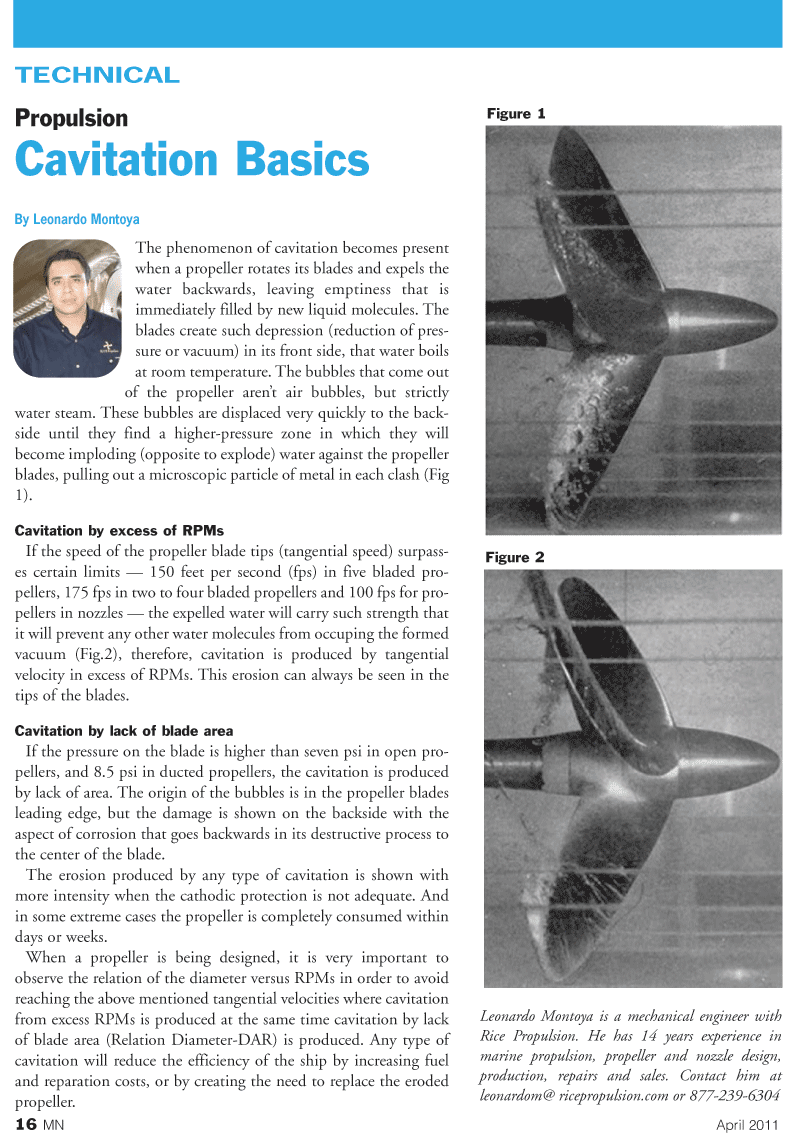
Page 16: of Marine News Magazine (April 2011)
Offshore Energy Edition
Read this page in Pdf, Flash or Html5 edition of April 2011 Marine News Magazine
16 MN April 2011
TECHNICAL
The phenomenon of cavitation becomes present when a propeller rotates its blades and expels the water backwards, leaving emptiness that is immediately filled by new liquid molecules. The blades create such depression (reduction of pres- sure or vacuum) in its front side, that water boils at room temperature. The bubbles that come out of the propeller aren’t air bubbles, but strictly water steam. These bubbles are displaced very quickly to the back- side until they find a higher-pressure zone in which they will become imploding (opposite to explode) water against the propeller blades, pulling out a microscopic particle of metal in each clash (Fig 1).
Cavitation by excess of RPMs
If the speed of the propeller blade tips (tangential speed) surpass- es certain limits — 150 feet per second (fps) in five bladed pro- pellers, 175 fps in two to four bladed propellers and 100 fps for pro- pellers in nozzles — the expelled water will carry such strength that it will prevent any other water molecules from occuping the formed vacuum (Fig.2), therefore, cavitation is produced by tangential velocity in excess of RPMs. This erosion can always be seen in the tips of the blades.
Cavitation by lack of blade area
If the pressure on the blade is higher than seven psi in open pro- pellers, and 8.5 psi in ducted propellers, the cavitation is produced by lack of area. The origin of the bubbles is in the propeller blades leading edge, but the damage is shown on the backside with the aspect of corrosion that goes backwards in its destructive process to the center of the blade.
The erosion produced by any type of cavitation is shown with more intensity when the cathodic protection is not adequate. And in some extreme cases the propeller is completely consumed within days or weeks.
When a propeller is being designed, it is very important to observe the relation of the diameter versus RPMs in order to avoid reaching the above mentioned tangential velocities where cavitation from excess RPMs is produced at the same time cavitation by lack of blade area (Relation Diameter-DAR) is produced. Any type of cavitation will reduce the efficiency of the ship by increasing fuel and reparation costs, or by creating the need to replace the eroded propeller.
Propulsion
Cavitation Basics
By Leonardo Montoya
Figure 2
Figure 1
Leonardo Montoya is a mechanical engineer with
Rice Propulsion. He has 14 years experience in marine propulsion, propeller and nozzle design, production, repairs and sales. Contact him at leonardom@ ricepropulsion.com or 877-239-6304

 15
15

 17
17
